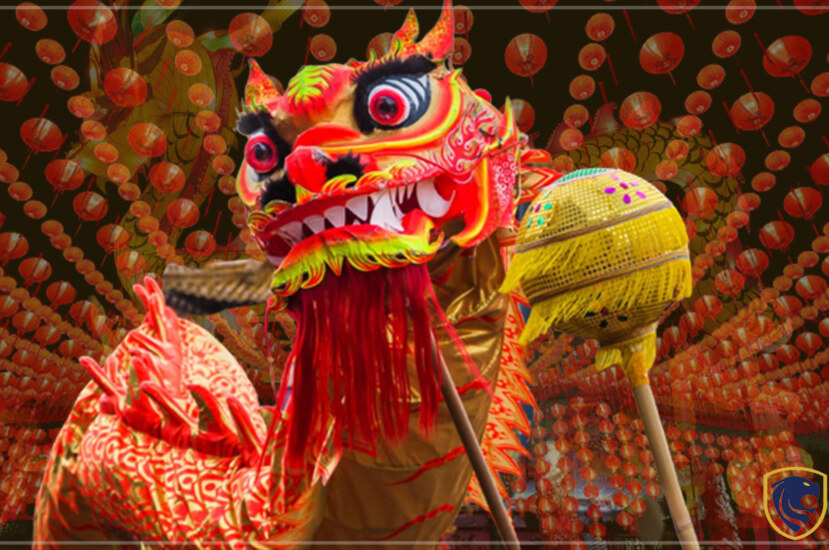Chinese New Year is the most important holiday in Chinese culture, and it falls on different dates each year according to the Chinese lunar calendar. The first day of the Chinese New Year is known as the “Spring Festival” or “Chinese Spring Festival” and occurs on January 23rd or 24th. The Spring Festival lasts for fifteen days and ends with the Lantern Festival on February 15th, which marks the end of China’s Lunar New Year celebrations.
The festival celebrates a time when nature was prosperous, where people were healthy and wealthy as opposed to during the winter season when everything was barren or dying off. The celebration dated back to the Shang Dynasty (1750 – 1046 BCE) and was an important celebration during the Zhou Dynasty (1045 – 256 BCE). It is now popular in all corners of the world.
Many customs, myths, and legends surround this Chinese New Year’s Celebration. However, most center around family gatherings, visiting ancestral temples and eating special treats and food offerings made to ancestors and gods.
What to do in Chinese new year
The most well-known holiday tradition involves people cleaning their homes in preparation for the New Year. In addition to cleaning up their own homes, families will also clean up their ancestral hall or graveyard in honor of their ancestor’s spirits.
During the New Year celebration, families will also visit their relative’s or best friends’ houses for a special token gift known as liàngyǔ. This gift is usually something symbolic of the relationship, such as dishes with matching designs or colors. Sometimes, people might give out sweets, such as red envelopes filled with money. One of the most common reasons to exchange Liang Yue is to reaffirm bonds and build relationships that may have been damaged in previous years.

What is Chinese New Year
Another tradition during this time of year involves buying and releasing miniature paper boats on waterways into lakes and rivers. The boats are released into waterways to carry the boat owner’s wishes away and downriver towards their destination. It is a tradition that dates back to the Zhou Dynasty. At that time people made small paper models of boats. And set them afloat on rivers in order to commemorate their ancestors. This symbolic act would allow their ancestors’ spirits to be carried over water to their home village.
Traditional delicacies
A notable New Year custom is the serving of zongzi, a special kind of glutinous rice dumpling wrapped in bamboo leaves. This tradition dates back thousands of years, as evidenced by writings found on oracle bones from the Shang dynasty. Zongzi are eaten in order to bring good fortune and wealth.
Another popular tradition is the eating of tangyuan, a type of sweet dumpling made from glutinous rice flour. In contrast to zongzi, tangyuan is filled with different fillings of red bean paste or lotus paste. These delicious dumplings represent a full belly and prosperity for the coming years.
In addition to food and treats, firecrackers are also an important part of the New Year’s Celebration in China. Firecrackers are typically set off as a symbol of good luck and happiness. When lighting the firecrackers, people make a wish for good health, safety, and prosperity for the coming year in hopes of bringing good fortune and blessings.
There are many customs associated with the Chinese New Year holiday, but most revolve around family traditions and social interactions. The Chinese, over the past thousand years, have incorporated their shared cultural stories, cultures, and their own beliefs into this holiday. Most people look forward to this time of year. Because it allows them to reunite with family members who they may not see every year. It’s a tradition, fun, and joyous time to come together.

Chinese New Year Traditional delicacies
holiday parades
The most important part of Lunar New Year celebrations is the holiday parades. That occur in every city throughout the country beginning on January 31st. Or about a month before the Lunar New Year starts. The parades are the main way of showing off the best of China, whether through costumes, floats, and other elaborate details. In some places, people also celebrate by lighting fires in their homes to ward off evil spirits.
In addition to participating in parades, people have developed other ways to show their pride in the Chinese New Year. Some houses decorate their roofs with white paper cranes or lights representing good luck. Some others use traditional red lanterns or red lights on what is known as ‘Chinese New Year Light Street.’
Chinese New Year Prayers
As part of Lunar New Year celebrations, their prayers are said every meal before at certain times throughout the day according to many religious traditions. These prayers include the Nine Emperor Gods’ Prayer, for good luck and success, to the Chinese gods for protection and happiness.
The Lunar New Year is also one of the most important holidays in China. Most people head home to visit family and friends, bringing along snacks and wine. The Chinese New Year is a great time of year to get together with friends and have a good time in celebration of the new year!

What is Chinese New Year
Chinese New Year History
The Lunar calendar has been used in China since it was first made in 2205 BC by Emperor Huang Di to regulate agriculture. Its origins are in the cycles of the moon. And its effects on water, which has been important to Chinese culture for thousands of years.
The Chinese New Year was long celebrated as a time of peace, happiness, and joy. It was a time when animals were not eaten, wars were not fought. And schools were closed so people could reunite with family members.
The Chinese New Year is celebrated by ceremonies that date back thousands of years. One such ceremony is the “T’ai Shan Festival,. That features lion dancers and acrobats who go from house to house during celebrations in early February. This is to bring good luck and happiness before the New Year begins. Another activity is the “Shanghai Eight Immortals” race. There people scatter coins into a well in order to cast virtue and good luck. Another is the “1,000 Hand Clap Song,”. There people clap their hands slowly to ward off evil spirits and bring happiness. The Chinese New Year dates back thousands of years and has many different aspects to its celebrations. It is a time of peace, happiness, and fun for all!




